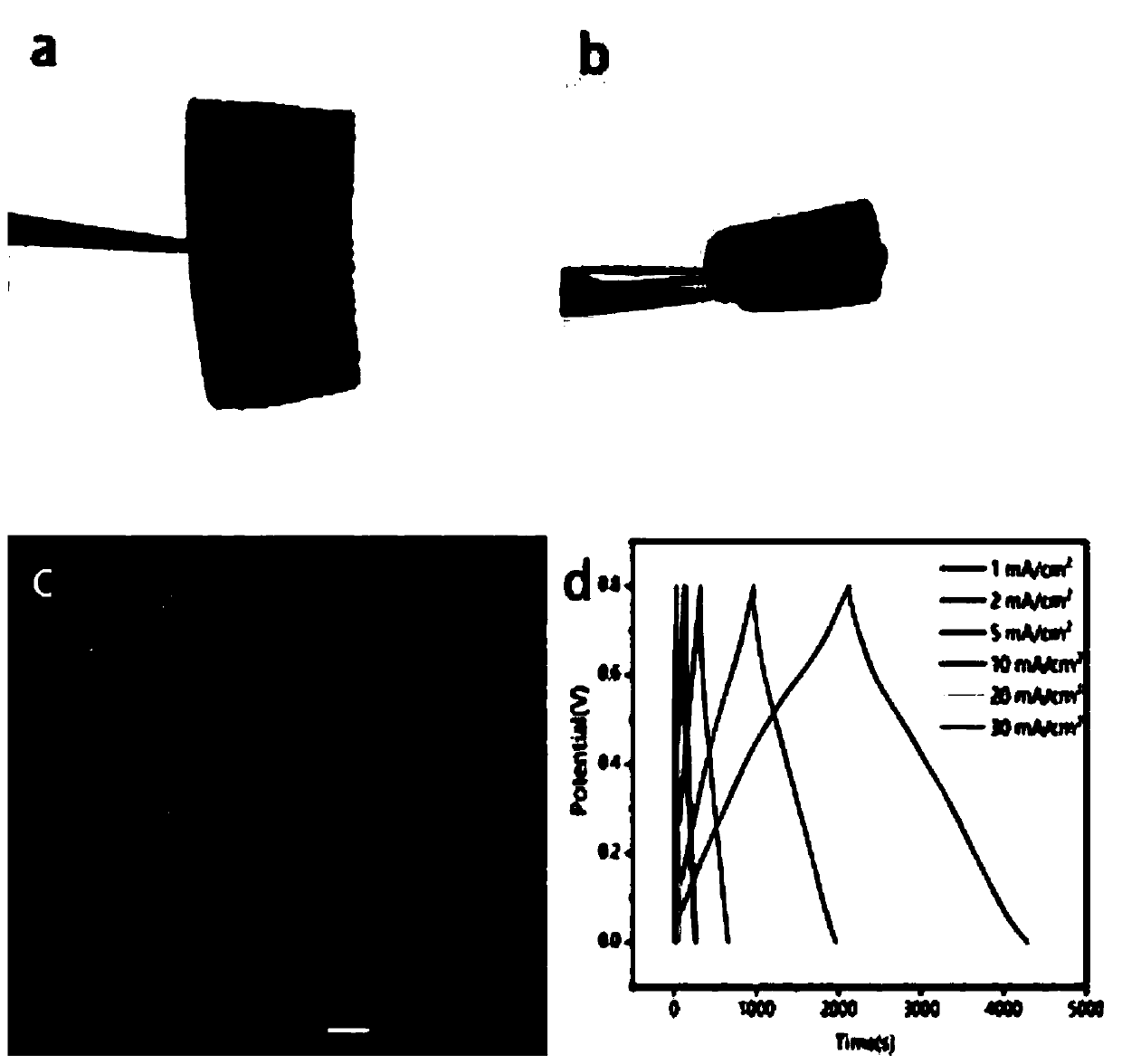Preparation method of wood-based flexible composite electrode material
A composite electrode and base flexible technology, which is applied in the field of wood-based energy storage materials, can solve the problems of poor flexibility and complicated preparation process, and achieve the effects of high conductivity, improved electrochemical performance, and excellent electrochemical performance
- Summary
- Abstract
- Description
- Claims
- Application Information
AI Technical Summary
Problems solved by technology
Method used
Image
Examples
Embodiment 1
[0044] (1) The balsa wood is sliced along the growth direction to obtain a wood substrate with a thickness of 0.5mm and a length and width of 4.5×2.5mm.
[0045] (2) The wood substrate obtained in step (1) was rinsed repeatedly with deionized water, and then placed in a vacuum drying oven at 60° C. for 12 hours for later use.
[0046] (3) Put the sample in step (2) into 2.5mol / L NaOH and 0.4mol / L NaOH 2 SO 3 In the mixed aqueous solution, heat in a water bath at 90°C for 90min.
[0047] (4) The delignified wood substrate in step (3) was washed sequentially with ethanol and deionized water, and the sample was first frozen in a refrigerator for 12 hours, and then transferred to a freeze dryer for freeze-drying at -45°C for 36 hours.
[0048] (5) Pretreat the carbon nanotube powder with concentrated sulfuric acid and nitric acid, add acetone solution, ultrasonically disperse for 1-2 hours, centrifuge with a high-speed centrifuge, and take the upper layer solution to obtain a ...
Embodiment 2
[0055] (1) Slice the balsa wood along the growth direction to obtain a wood substrate with a thickness of 0.5mm and a length and width of 4.5×2.5mm.
[0056] (2) The wood substrate obtained in step (1) was rinsed repeatedly with deionized water, and then placed in a vacuum drying oven at 60° C. for 12 hours for later use.
[0057] (3) Dip the wood substrate in step (2) into NaClO 2 solution, with CH 3 Adjust the pH to 4.6 with COOH, heat and boil for 1h.
[0058] (4) The delignified wood substrate in step (3) was washed sequentially with ethanol and deionized water, and the sample was first frozen in a refrigerator for 12 hours, and then transferred to a freeze dryer for freeze-drying at -45°C for 36 hours.
[0059] (5) Pretreat the carbon nanotube powder with concentrated sulfuric acid and nitric acid, add acetone solution, ultrasonically disperse for 1-2 hours, centrifuge with a high-speed centrifuge, and take the upper layer solution to obtain a carbon nanotube dispersion...
Embodiment 3
[0066] (1) Slice poplar wood along the growth direction to obtain a wood substrate with a thickness of 0.5 mm and a length and width of 4.5×2.5 mm.
[0067] (2) The wood substrate obtained in step (1) was rinsed repeatedly with deionized water, and then placed in a vacuum drying oven at 60° C. for 12 hours for later use.
[0068] (3) Put the wood substrate in step (2) into 2.5mol / L NaOH and 0.4mol / L NaOH 2 SO 3 In the mixed aqueous solution, heat in a water bath at 90°C for 90min.
[0069] (4) The delignified wood substrate in step (3) was washed sequentially with ethanol and deionized water, and the sample was first frozen in a refrigerator for 12 hours, and then transferred to a freeze dryer for freeze-drying at -45°C for 36 hours.
[0070] (5) Pretreat the carbon nanotube powder with concentrated sulfuric acid and nitric acid, add acetone solution, ultrasonically disperse for 1-2 hours, centrifuge with a high-speed centrifuge, and take the upper layer solution to obtain a...
PUM
| Property | Measurement | Unit |
|---|---|---|
| Thickness | aaaaa | aaaaa |
| Specific capacitance | aaaaa | aaaaa |
| Specific capacitance | aaaaa | aaaaa |
Abstract
Description
Claims
Application Information
 Login to View More
Login to View More - R&D
- Intellectual Property
- Life Sciences
- Materials
- Tech Scout
- Unparalleled Data Quality
- Higher Quality Content
- 60% Fewer Hallucinations
Browse by: Latest US Patents, China's latest patents, Technical Efficacy Thesaurus, Application Domain, Technology Topic, Popular Technical Reports.
© 2025 PatSnap. All rights reserved.Legal|Privacy policy|Modern Slavery Act Transparency Statement|Sitemap|About US| Contact US: help@patsnap.com

